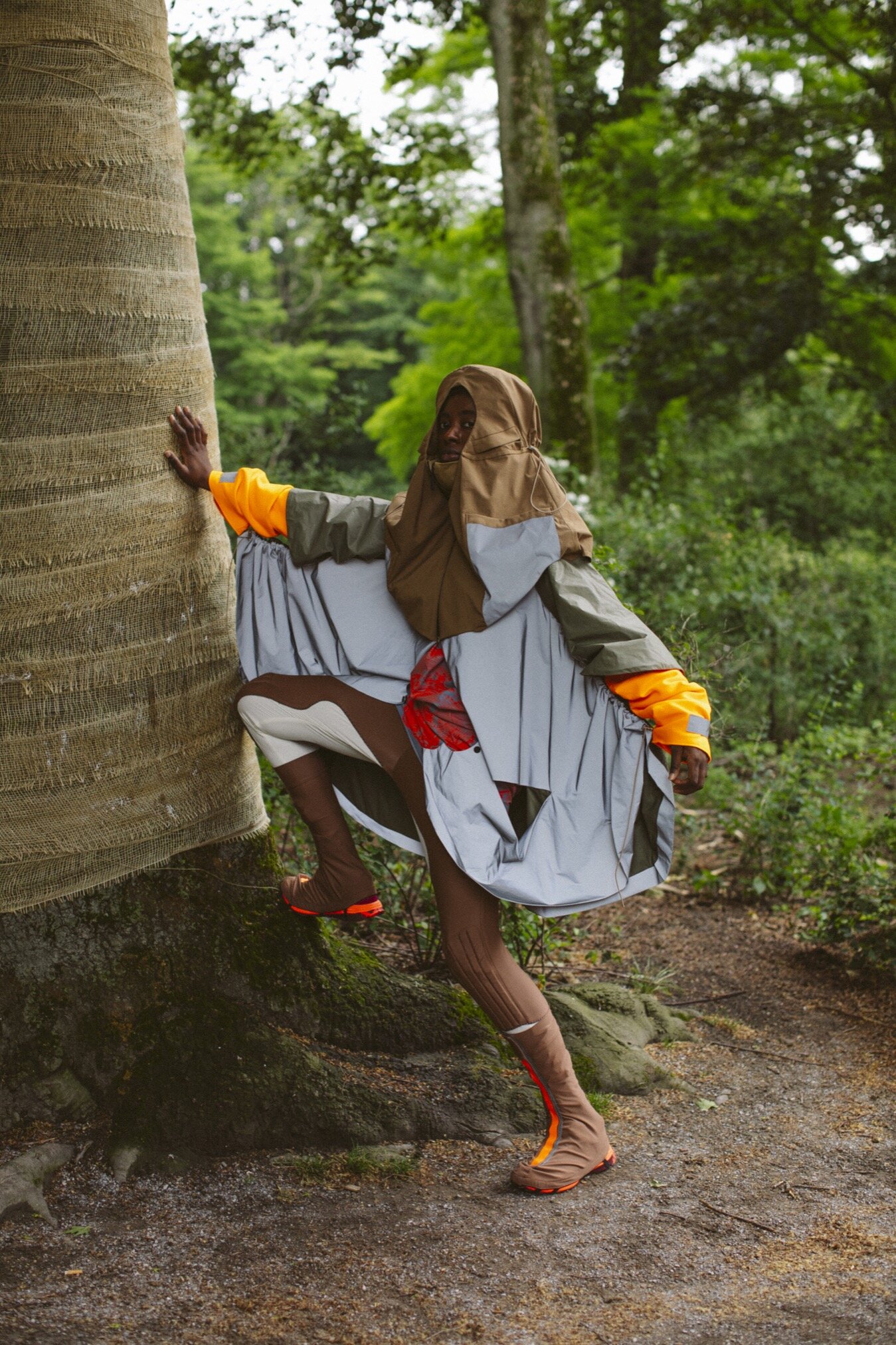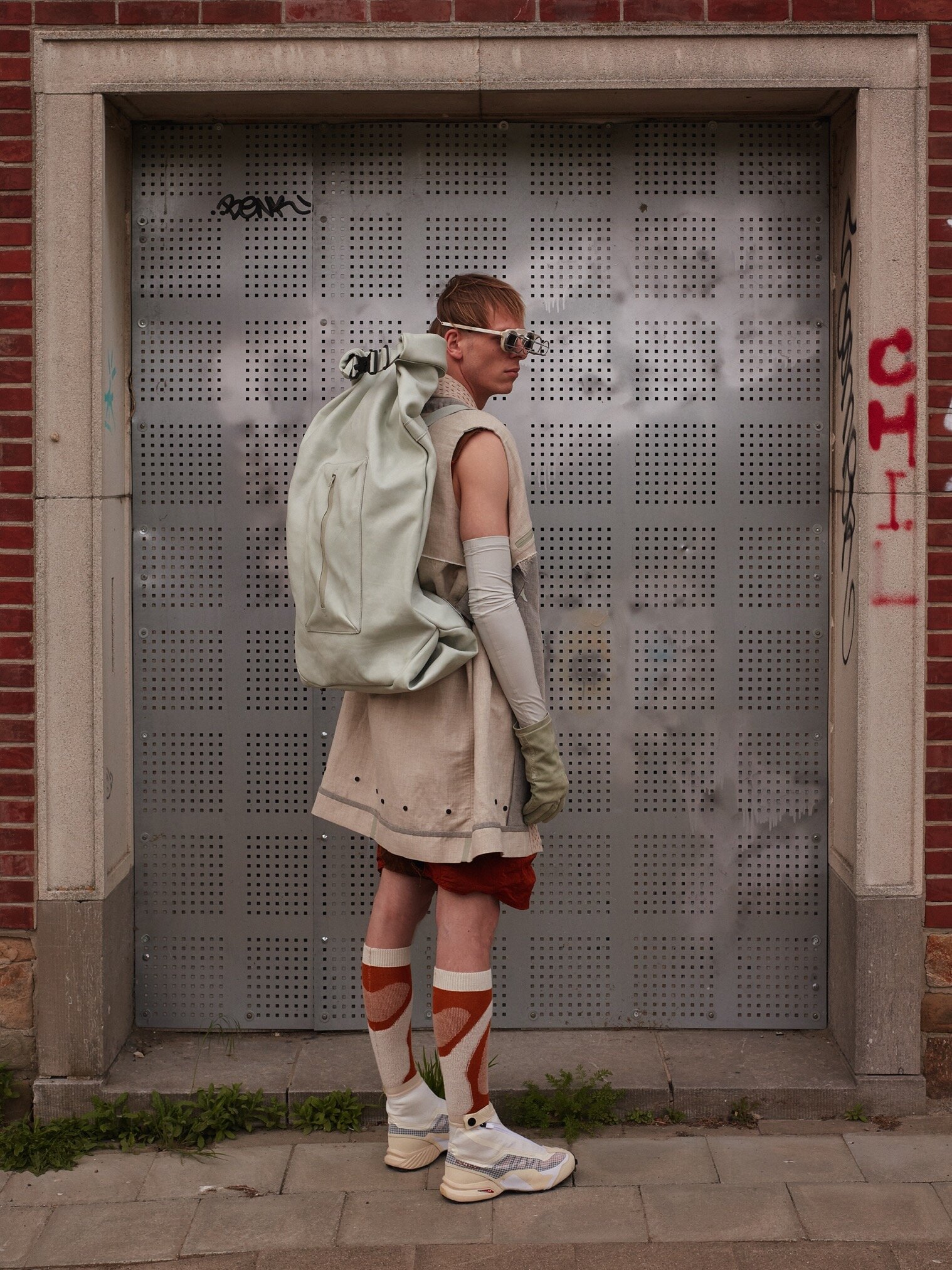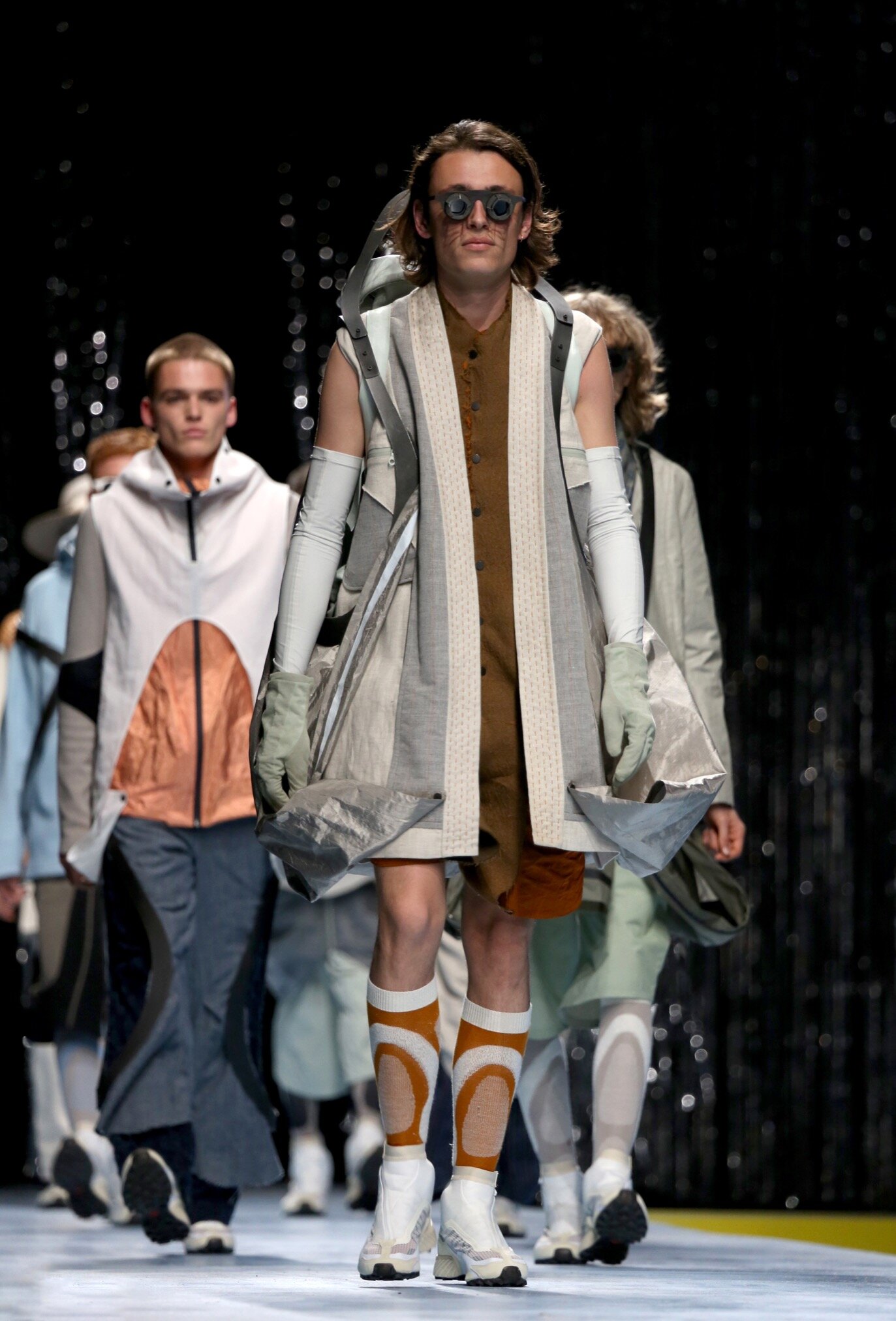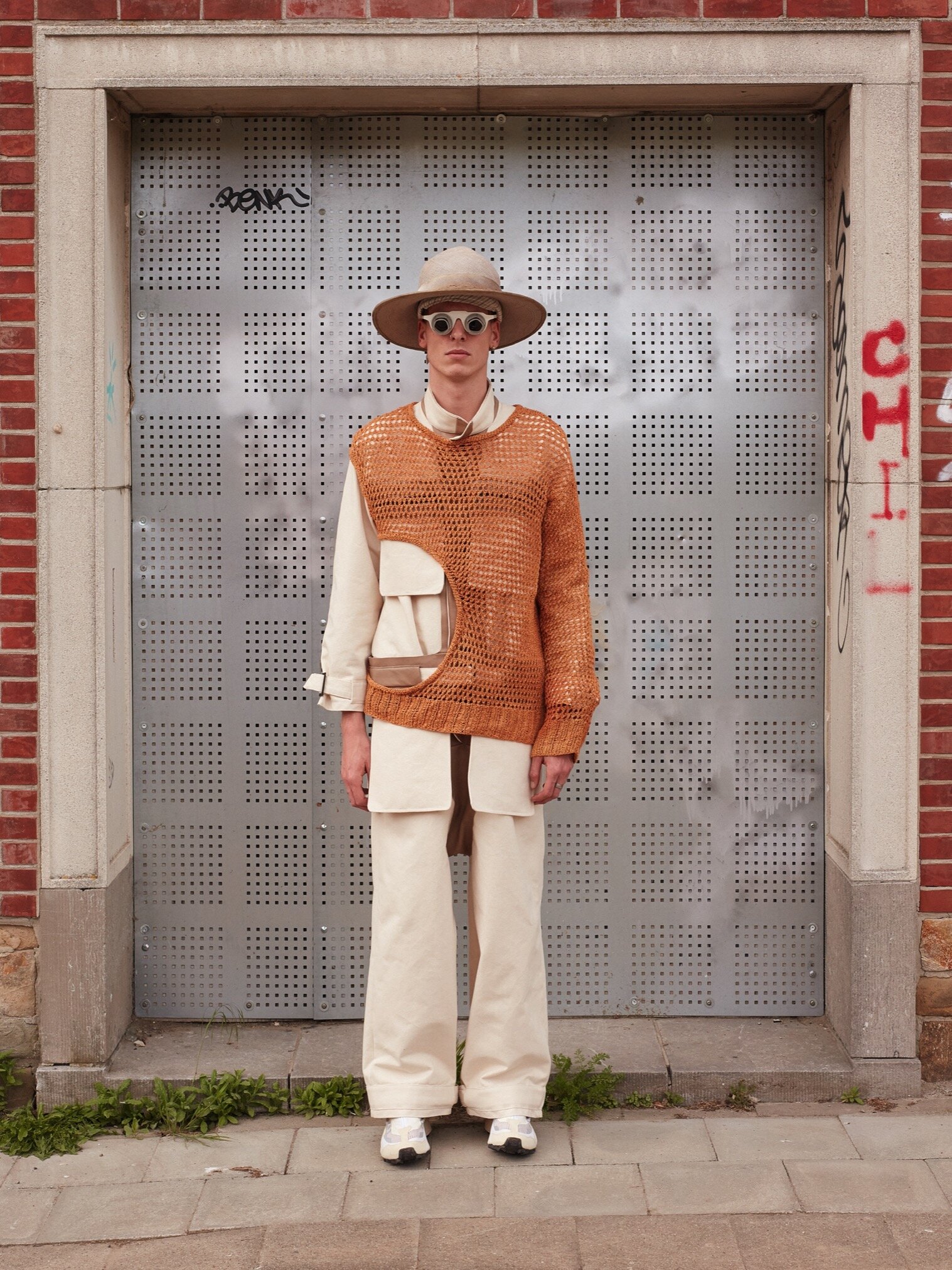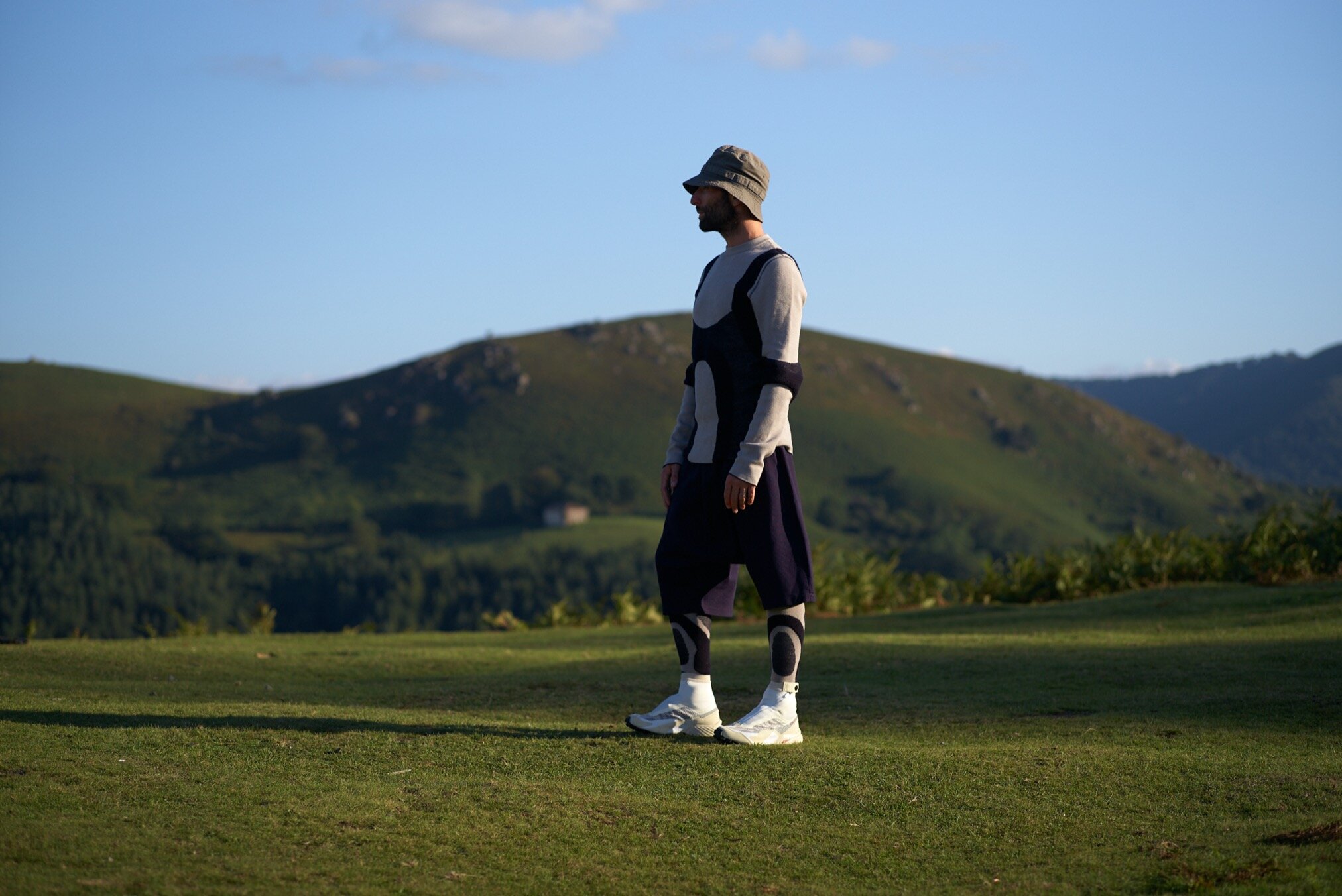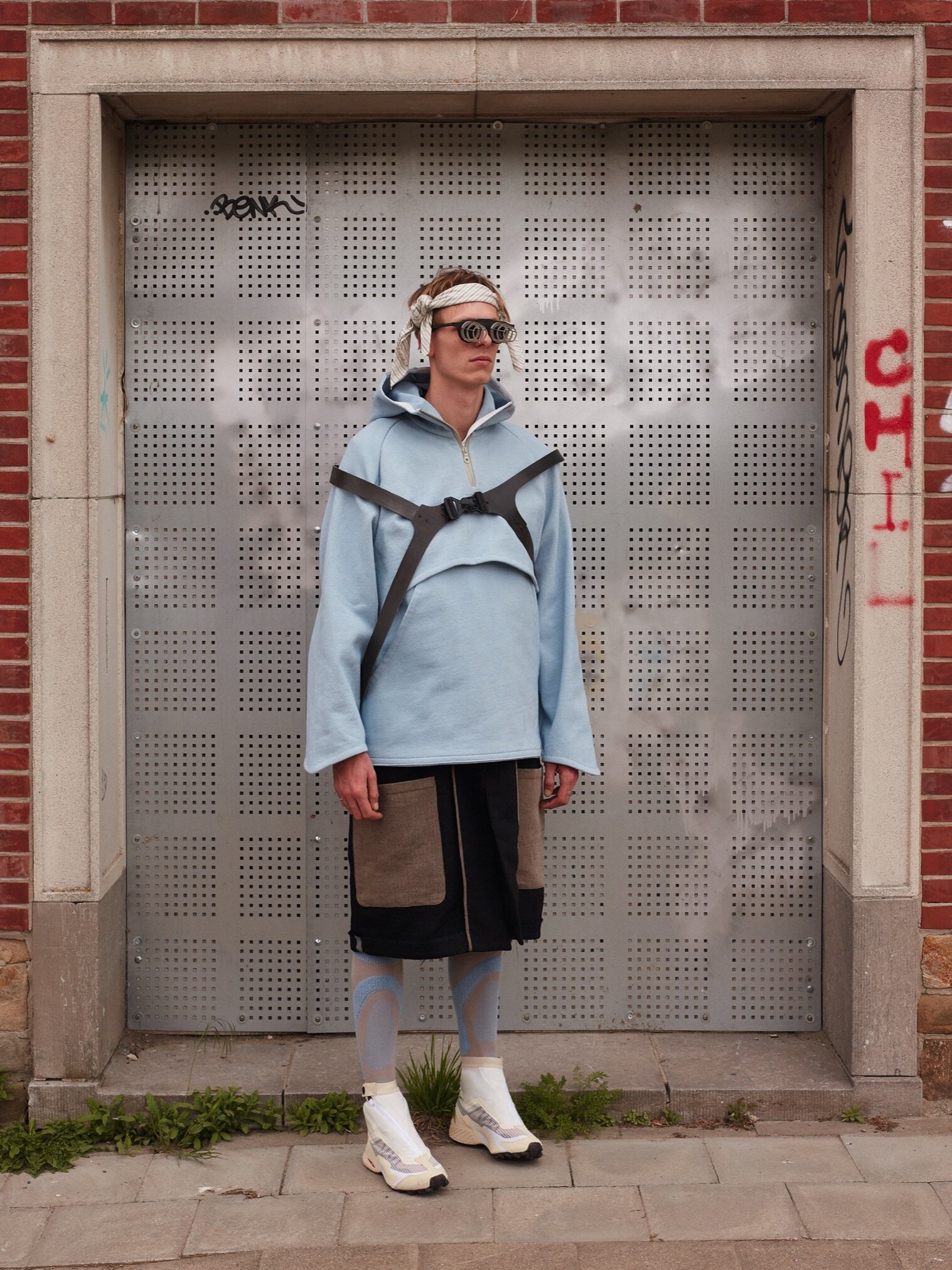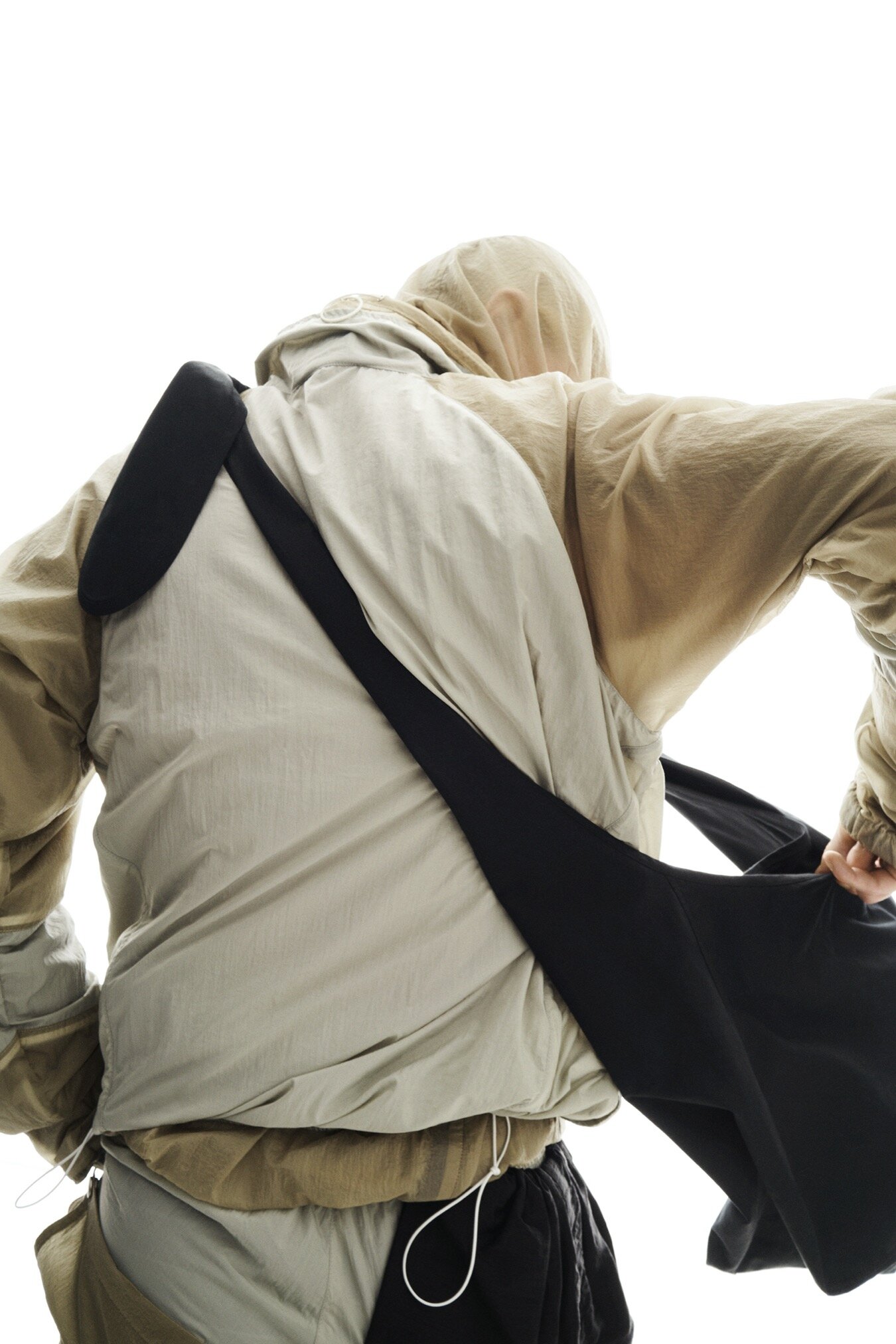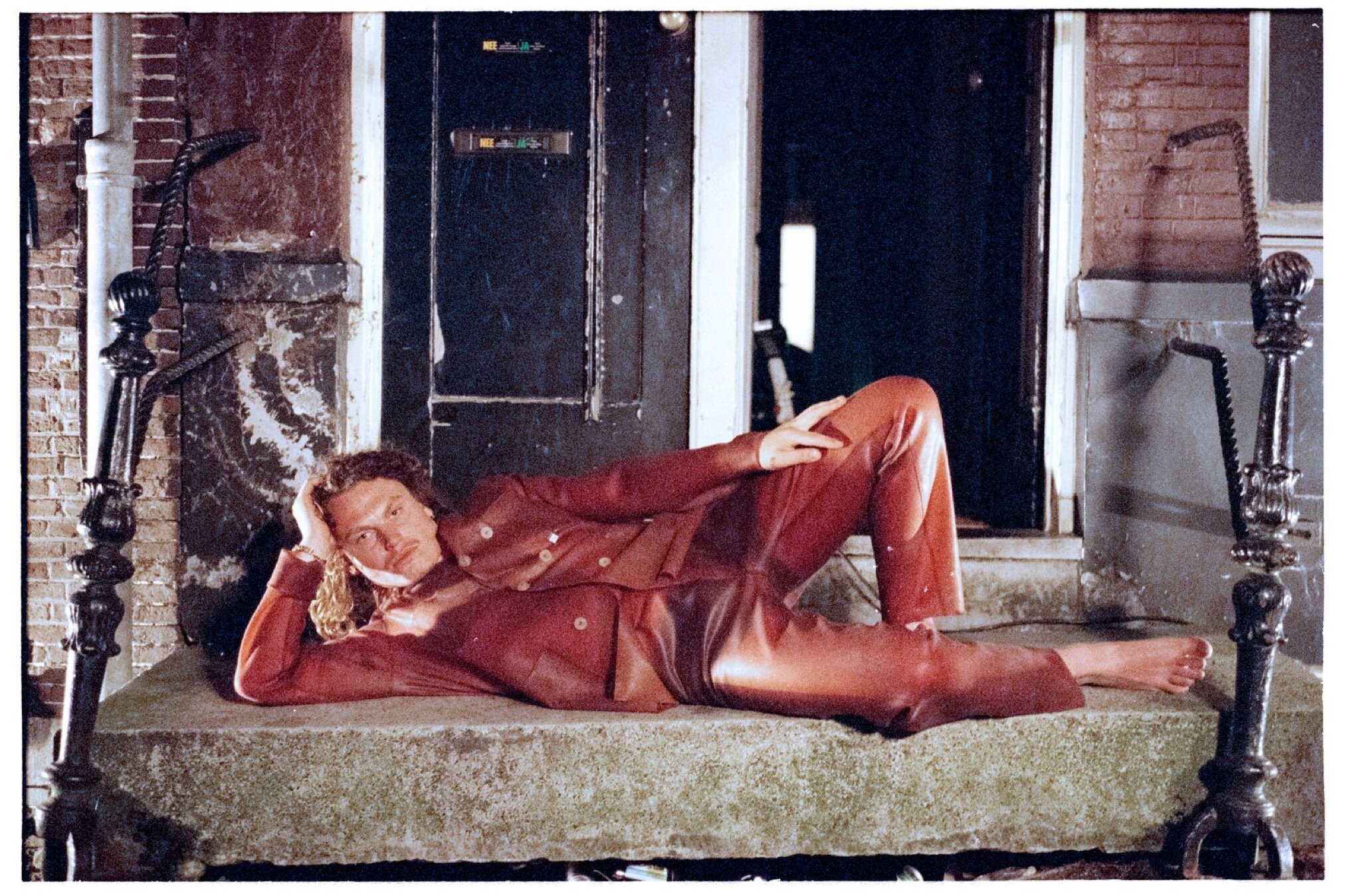TELLING A MESSAGE THROUGH GARMENTS: LOUISE SAFAYAN & VINCENT THÜRSTEIN

The SABUKARU team is always looking for the people who shape our ideas of tomorrow.
Clan Destin/Louise Safayan; @Victor Pattyn
We look at young creatives, who, in possessing promising prospects, tear up old patterns and bring a fresh perspective – be it in action or in ways of thinking. And where, if not in the fashion colleges around the world, can you find these people?
Many fashion design icons start their careers in schools like Central Saint Martins in London, Parsons in New York or the Bunka Fashion College in Tokyo. Another highly rewarded school is the Antwerp Royal Academy of Fine Arts. Designers like Haider Ackermann, Martin Margiela or “The Antwerp Six” gave this place a special reputation.
The last-named “Antwerp Six”, containing Ann Demeulemeester, Dries Van Noten, Dirk Bikkembergs, Walter Van Beirendonck, Dirk Van Saene and Marina Yee, put this school on the map of elite fashion schools. The fact that both Margiela and “The Antwerp Six” graduated during the same year, shows the quality of this powerful talent engine. Since then, the graduates strive to live up to this unmistakable reputation.
This is definitely a reason to take a closer look at promising talents and future graduates of the Antwerp Academy.
‘Mokushiroku’ by Vincent Thürstein
‘Clan Destin’by Louise Safayan
Vincent Thürstein and Louise Safayan have, in the time they’ve spent there, impressively showcased their talent. They met during their undergraduate in 2016, and instantly felt connected in their perspectives on fashion. This bond led them to work together on several projects. One project was a collaboration with outdoor giant Salomon®.
Vincent and Louise helped to create a special version of the Snowcross Tracking shoe. With the upper part of the shoe being inspired by the drying of fishermen’s nets, and the fragments on the upper body by the furniture designed by Marcel Breuer, you can see the boundaries of different fields being broken. This interdisciplinary way of thinking mirrors their work and creates its own functionality and aesthetics.
Mokushiroku/Vincent Thürstein; @Lee Wei Swee
Vincent, who originally comes from a small village in rural Bavaria, southern Germany, has always had a strong relationship with nature and the surrounding Alps. His grandad was a metalworker, and Vincent himself cites looking over his shoulder whilst he was working as infusing an interesting way of thinking into his design process. In his Bachelor Collection, ‘Mokushiroku’, he used many different materials and fabrics and looked towards architecture and interior design, rather than fashion, for inspiration.
Vincent wanted to embed his clothing with a comfortable feeling that imitated the lived-in notion that a house or a garment can possess, and therefore treated his pieces with a process of oxidation that mirrors the patina placed on buildings. This placed an aged but familiar touch onto his items.
Louise has Persian roots and grew up in the French Basque Country surrounded by the Pyrenees, in front of the Atlantic. This environment made it possible for her to spend time in nature all year round. Hiking, surfing and skiing all drove her towards an interest in the symbiosis of nature and man. Building on this outdoor-based element, for her Bachelor collection, Louise utilised the relationships between family and nature present in Scottish Clans to create four silhouettes for women.
This collection was a tribute to women who suffer in hostile environments, and her garments took on a double sided role: they offered protection to the women who wore them, as well as binding them to each other - as social camouflage.
Both: Mokushiroku/Vincent Thürstein; @Lee Wei Swee
Over time the duo grew together and faced the high demands of the Academy. Going outdoors to bring inspiration from nature into the labs and merging it with elements from their regional heritage is all part of their idea of fashion. In taking inspiration from unconventional areas, the two are regarded as some of the most interesting future graduates of the highly regarded Antwerp Royal Academy of Fine Arts.
The Sabukaru team met both designers in 2019 in Tokyo and carried on the dialogue and bond into the year 2020.
Louise Safayan & Vincent Thuerstein @Taehyun Lee
Dear Louise and VIncent, Could you please introduce yourself to the Sabukaru network?
We are a french/german duo, passionate about arts, textiles and garments. Louise comes from Guethary, Basque Country, Fr. and Vincent from Evenhausen, Bavaria, De. We both study at the Royal Academy Of Fine Arts - Fashion Department, Antwerp since 2016.
Can you please both tell us a little bit about your idea of design, fashion and function. What are the motives and values behind your work and design language?
Thürstein @Marnik A. Boekaerts
We see the design, in our case in the fashion field, as an architect would imagine a house. The architecture includes a certain aesthetic and involves a way of living. It is the same in the construction of garments - if they are well-conceived and thought on a human scale, they will evolve with us in a lifetime. Our work starts with an idea we have. It is firstly a view on aesthetics, and then we follow the foundation of the garment through cuts and functions. We inform and empower our ideas with research on inspirations that can come from literally any world: art in any sense, interior design, photography, architecture, car design, cinema, nature, the shape of an object, a tour in a museum or going to Santiago de Compostela and meeting pilgrims! Anything that intrigues us is important. After these visual elements and memories inform details, we begin building the foundation of the garment, such as how the design will be defined by real lines, a cut, etc.
Fabric research and development is our main focus. Fabrics give a soul and life to a design, but also a structure and their aspect, which is essential to the piece. We definitely have an essentialist view of garments in mind.
Since we come from an outdoor and natural environment, the richness of the clothing culture and the traditions of our regions is part of our DNA. That’s why we naturally give designs a practical, useful dimension. It is important in the building of a clothing base to develop systems adapted to daily use and weather conditions. To support these functional and ergonomic aspects, we add what is for us aesthetic in the sense of a spirit. We produce colour combinations, well-made details, fabric treatments, and a variety of materials that tell our message in the most personal and sincere way.
Both: Clan Destin/Louise Safayan; @Victor Pattyn
With both of you not originally located in Belgium, how and why did you decide to study at the Fashion Department in Antwerp? What makes Antwerp special?
It is an academy of art known as being a creative hub, where the Antwerp Six (+1) studied and brought a new view on fashion in the ’90s as avant-gardists. But it is most of all a school where students have to go over boundaries, where we make decisions, we solve problems, we push our limits and we flirt with pressure all day long. But, pressure makes diamonds! That’s one of the maxims of Antwerp city (diamond heartland), and it is pretty true. We are guided to think and work on our own, which was a totally different and new way of working for us. We were both interested in this push on creativity and limits but also by the way of teaching, always bringing us to think in the most artistic way (techniques used, vision, explorations). The experimental dimension given to artworks is also what we liked to practice and learn the most.
When did you recognize that you could work together on a professional basis?
In general, we are on the same wavelength: we share a madness for aesthetics and give very specific attention to the idea behind our work. Most importantly, we have a similar view on the way we see and imagine fashion tomorrow. It was clear for us, we had to bring this together in common work.
Besides, we both have a mutual passion for the traditional garments of the areas where we grew up, we systematically work with them and make them appear in our works recurrently.
With the heritage of Basque, Persian, and Bavarian culture, does cultural heritage play a role in your creative process?
As old people might end their life in the place where they grew up, we also naturally come back to the elements that we like the most in our roots. But we study them, work on them to integrate them differently and express ideas that differ from our cultural heritage. It is in another context of working and scenery that we call upon our roots and culture. We mix them with other topics, confront them together, and put ideas out of their comfort zone to create interesting and unexpected results.
With nature and environment in mind, a lot of brands are shifting their focus to a more sustainable approach. How big of an impact has sustainability on your design process?
As a ‘farm to table’ system would operate to feed humans from the farm to the plate, we try to work with people we know, who are making fabrics close to us, and who respect a tradition and craftsmanship to clothe humans. We are still students, thus, at our level, our solution so far was to work with deadstock of fabric companies from neighbouring countries. We also worked on very innovative materials or very artisanal fabric developments, with local suppliers from our areas, from the fabric manufacturer to our atelier. We also fully developed some fibres by ourselves, such as wool, where we worked in a small wool manufactory, to make paddings. This is our most sustainable system.
Talking about big corporations. What do you think are the biggest issues the fashion industry has to face at the moment and do you have ideas on how to overcome it?
The transition is brutal because of years of ignorance and denial, but the changes we are now living should have been anticipated and started smoothly. We all know that fashion is the second most polluting industry in the world. The fashion industry forgot its most important role: clothing humans in a reasonable way. Fashion should start educating consumers to buy reasonably, by being aware of the issues, and reduce the number of collections that are encouraging everyone to consume too much. Producing better quality of clothing is ESSENTIAL. We should seriously consider thinking smaller but more realistically and questioning what is necessary. This is how producers and buyers can both have a positive impact on our cultural footprint and influence our epoch positively. Buy less, but smarter. Producing differently, too, not only locally but also taking environmental issues very much into account should be at the very heart of the manufacturer’s thoughts. Including recognition of the use of certain fibres, since most of them are highly polluting or toxic in the way they are produced, such as cotton. Fewer items produced but better made and conceived to last in the long-term.
Vincent, your Bachelor Collection ‘Mokushiroku’ featured fabrics and materials from all over the globe, how did you find all the different fragments? What were your research methods?
I look more towards architecture or interior for inspiration. It is the same for fabrics - a lot are not out of the fashion field, instead, they are used for interior purposes and are more architectural-inspired. I like the process of buildings which get a patina with time. When a house is new you don’t feel very home in it. As you live in it, you make it your own. It is the same with clothing. That’s why I treat my fabrics in a certain manner. I rinse and wash them, dye or oxidise them to give them a certain haptic and feeling of home. I left hems and armholes raw and unfinished to support that aspect of ageing and getting more individual over time. With wearing them they get a different feel on your body and it becomes part of your own, even in a new context, so the cloth gets a life. For my latest collection, I created a hypothetical story around isolated folk, who, in surviving an apocalypse, would rise towards re-exploring our world. Here, they would find fragments of our destroyed planet, such as architecture, sculptures, interior etc. From these fragments, they would rebuild our world in their own way. That’s what I also want to happen with my cloth.
Your appreciation for different materials goes back to your grandfather. Can you tell us what experiences made you interested in all the different materials you’re working with?
Mokushiroku/Vincent Thürstein; @Lee Wei Swee
My grandfather was a professional metalworker and was strong in handcrafting - that’s how I got my first skills for metal and woodworking. I would describe myself more as a sculptor rather than a designer. Shaping forms and creating a universe with the eye for details is, for me, more like a sculpting process. Like you have wax in your hand and with the subconsciousness of your mind, you create your work. A garment is interesting for me through the materials which can be related to other disciplines and purposes which then brings the garments into a new context.
Both: @Marnik A. Boekaerts
Can you elaborate a bit about the collaboration on eyewear with Theo? Where did the idea for the binocular like glasses originate?
I started working with Theo with the idea in mind to make architectural objects as wearable eyewear. The thought behind it was to be able to change the object with a screw system to wear them more simply and purely. The idea of binocular glasses came from goggles of Japanese fisherman and their fishing traps, which reminded me of the shape and construction of the metal sculptures of Alexander Rodchenko and his photography of electricity towers. Serge Bracké, the head designer of Theo, helped me appreciate these special objects, which were made in metal and buffalo horn. As experiments in a weathering process, in which these electricity towers would also change their patina, I treated the metal frames with acids to get a different surface and colour array.
Louise, you’ve chosen to focus on Clans in your Bachelor Collection ‘Clan Destin’. Where does the interest in outdoor-based clans come from?
I have always been attached to the Scottish Clans, to their culture and the way they were organized as a society. Largely thanks to this culture and the beauty of the country, Scotland has always been a huge inspiration for me. The Scottish estate tweeds, the family clan, but also the fabric, the tartan. A textile, woven in the family mills that embodies the heritage and lands of the Scottish clans, their line. The relation between family and nature is, I think, strong in this cultural heritage, and I feel close to this spirit. I worked on four silhouettes for four women that I saw as a Clan - an army of girls. The tartan emblem I made for this collection is represented by a wood trunk, a tree print as a human fingerprint. I printed the tree stump on fabrics, in neon orange, that both help the women to be visible and identifiable to other members of the clan, and to be the emblem and DNA of the Clan Destin.
How important was the fact of functionality and outdoor suitability in the creation process of the collection? You seem to see real women behind the collection ‘Clan Destin’, did someone inspire you in your work?
Functionality or outdoor is one of the aspects I give to it. I worked with outdoor and functional garments as a clothing suggestion to the collapsology movement and imagined protective gear for a collapsing near future. It echoes the times we are living right now: everything is out of control and we all need to anticipate fast what will come next. I thought of this collection as a tribute to women who suffer and try to survive in an uncomfortable position, in the hostile world collapsing around them. I wanted my garments and textile to refer to nature, and to act as a regenerative solution - a helpline. Most of us have felt like an outsider somewhere or in a situation where we didn’t feel accepted. It was the start of my research, to which I added elements that I re-worked, from clandestine, camouflage techniques, protection gears and details from the hunting-shooting culture. I imagined this clan as an army of strong, fierce, women, who never abdicate. They are part of the resistance of women who are either fighting in the army in Syria, cross the Mediterranean with their children as migrants, or they are combating sexual and moral violence in Hollywood. I wanted their garments to be their shield. And, thanks to their hunter ancestors, the Clan Destins acquired the skill of dissimulating in any condition. The strong women I have in mind are really existing. Anyone could be from the ‘Clan Destin’. I thought it was interesting to imagine a real woman as an avatar, in lands as much as in an urban context, who would be in perpetual evolution in the threatening world of today and growing in the world of tomorrow. I didn’t give it a clothing perspective at first.
You worked with different materials, what did you use?
Clan Destin/Louise Safayan; @Victor Pattyn
I wanted the fabrics worn by the Clan Destin women to be their second-skin-camouflage, to melt into elements and still be protected - they can hide from their enemies and be visible to their allies. I used materials that suit weather conditions, fitting urban or outdoor situations. I mixed them with natural fabrics to bring back a human, comfortable and warm dimension. I give the textiles a specific effect by dying, waxing and leaving them outside to observe their reactions. Textiles are the first stage of my work construction - my relation to clothes is more tactile. I work on garments by first thinking and treating materials. It guides my final choices and I can bring them to a different context. I re-used and experimented with other materials, such as iron and cement. I wanted to shape a wearable protective object - a piece of armour, shaped as a bullet-proof jacket and built out of thin metal wires, with upcycled clay-shooting plates exploding all over. It is artisanal, so it has imperfections and soul, which is what I like. I tried to stitch these different mediums and disciplines together because I wanted character for the ‘Clan Destin’ women. For me, as a student, it was important to give an experimental and artistic point of view on clothing, rather than limiting my work to a wearable dimension only. There are no rules, I can try everything and move towards the unknown.
Design or functionality? What do you put first when creating a garment?
Functionality is a tool to make a design useful. There is a balance to reach between both of them as they complement and accompany each other. For us, building a strong idea prevails, as this is the raw material, the first step of construction. When we work together, we try not to deform our primary idea, we don’t force the lines of the designs. Design and functionality become one unit when they both participate to tell the story of our garments. But, not all garments need a function. What matters for us first is to make pieces that will become our own and that will evolve with us in the time.
And how would you define functionality? When can a clothing piece truly become functional?
We prefer the notion of essentials rather than pure ‘functionality’. Functionality has a dimension of need and usually refers to very specific garments and worlds. Giving a reason for a garment to be there gives it a functional aspect. Functionality is not the key to a good garment, it is a tool that gives access to options that make a garment more practical in daily life, or to live in certain conditions, or be adaptable to some situations. In other words, it is making our life a bit easier and it gives us more features in wearing clothes. In our case, we give a function to essentials, basics.
Please, give us an insight into how the collaboration with Salomon came together.
The work we did together with the Salomon team was a great project. We were really happy as students to work with such an emblematic house. We were looking for a brand that has the know-how and innovative perspectives in outdoor and mountaineering, to help us make the shoe meet our needs and ideas. In a bit less than a year of work, we developed a shoe model with the R&D team and the atelier Salomon, made in France.
What was your idea when you designed the snowcross track running shoe? What was the important note you wanted to attach to the shoe?
It was obvious for us both to work on this shoe model. We grew up wearing them or seeing them worn, so we felt like we knew them very well and we now had the chance to work on them! The upper part of the shoe is inspired by the layering techniques of fishermen when they dry their nets. The different layers of materials give an interesting colour composition of the washed-out materials under a sunbath and salt. The fragments on the upper shoe are inspired by furniture designed by Marcel Breuer. This model embodies a form of minimalism and mountaineering that we like. Besides the technical aspects, the shape of the spikes and the grip are elements that make the shoe visually strong. It was a great model to express both our collections and bring functionality together with our inspirations and view on aesthetic.
Both: Louise Safayan & Vincent Thürstein for Salomon®;
Were there any complications working together with a big brand as upcoming young artists? What did you learn from this process and will we be able to see more out of this collaboration?
Working with a house such as Salomon is a crazy experience at our stage. We learned a lot from this work process, like how to proceed step-by-step on a project together with a team, adapt our design to some limits, work together with skilled persons and in a totally different horizon than fashion. Every step matters, and it was essential to think about every detail to make the project work the right way. We will keep working in this direction, developing different savoir-faires and skills, situated at the intersection of interdisciplinary projects.
In a time where Techwear and outdoor gear became ‘mainstream’, what does it take to stand out?
Everything becomes mainstream at some point when it saturates. Cultures lose their soul and identity the moment they become accessible and over-exposed, which is the case of Techwear, but so many other cultures too. Unique work is defined by a personal language. Telling our message through garments is crucial - it is a rooted signature. It is necessary for us to always keep in mind the essential aspect of the garment, as well as its function, its role, and to keep it pure. As seen in the architectural work, ‘ornament is a crime’, we move away from decorative and superficial aspects when we think about our designs.
Both: Mokushiroku/Vincent Thürstein; @Lee Wei Swee
Hypothetical: If someone would give you an unlimited budget and access to all available materials, what product would you want to design?
Louise Safayan & Vincent Thürstein for Salomon®; @Cédric Bihr
We would develop exactly the project we are now working on together, but in this case, with more facilities! We are working on an ergonomic, pure, minimal garment. We chose to make a high-quality product by the use of well-made materials and manufacture of the pieces that suit a function with lasting purposes. This project has a bespoke dimension, from the atelier to the person who wears it - it's a small production. We also work on natural materials. The more organic, raw and pure as possible. Fabrics don’t have to be very refined and rich but simply well made. We prefer to make timeless pieces, those that will evolve with you. We don’t want to be part of only one world or be stuck in simplicity either. We want to open our view to other trades and crafts, to uncover the unsaid and bring options. To make it happen, we will work with different savoir-faires and cohabitate different sensibilities. We will keep developing innovative fabrics and pieces with skilled manufacturers or artists. We wish to develop fabrics that can be pieces of art, from their visual aspect but also from the way they are made. We think of textile as a painter's canvas. But, most importantly, this project keeps an experimental and artistic side - our soul.
What is next for you guys. Where do you want to set your focus in the future?
We are still studying in Antwerp for the moment, but as we just said, we are working aside on our own project. We always wanted to work together on what meets our cultures, skills, but also differences, and bring a point of view on our new Era of fashion. Regardless of the artworld or domain, you can expect us anywhere. Now’s The Time!
About the authors:
Peter is a writer who has devoted a lot of his activities to the Japanese culture. Partially located in Tokyo he academically studies many aspects of the Japanese society and culture to get a deeper understanding of Japan.
Jacob is a writer and chef based in Manchester, England. He specialises in environmental consultancy relating to food and fashion.
















